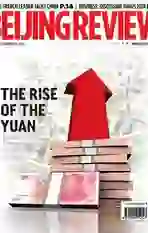Making the Yuan More Flexible
2014-02-25
The exchange rate of the Chinese yuan against the U.S. dollar reached new peaks 41 times throughout 2013, appreciating by nearly 3 percent in terms of central parity. During the past year, while currencies of all other BRICS economies depreciated against the dollar, Chinas yuan showed strong momentum and the trend is expected to continue in 2014.
The internationalization of the yuan requires its moderate appreciation to attract attention from the market. An excessively rapid rise of the yuan is not a good thing.
Normally a countrys currency appreciates when its economy poses strong growth, resulting in the currencys rising role in the international monetary market. In 2013, the Chinese economy had been sluggish until stabilizing in the third quarter, and Chinas voting share in the International Monetary Fund didnt increase within the year, which couldnt explain the yuans fast appreciation.
The appreciation of the yuan has significantly weakened Chinas role as“the worlds factory.” Many export-oriented enterprises experienced dramatic profit drops, with many even suspending their production. While export demand shows moderate recovery, the export registered negative contribution to Chinas economic growth in 2013.
Chinas export-oriented companies are mostly labor-intensive. If the yuan exchange rate continues its upward momentum in 2014, Chinas exports could suffer enormously, which could further affect the employment situation and even economic and social stability. As the yuan is not convertible under capital accounts, so the domestic market didnt show much response to the yuan appreciation.
China will comprehensively promote reforms this year, as decision makers focus on how to enhance national interests and protect peoples interests during the exchange rate reform. The main priority is to increase the flexibility of the exchange rate through reforming the exchange rate formation mechanism.
